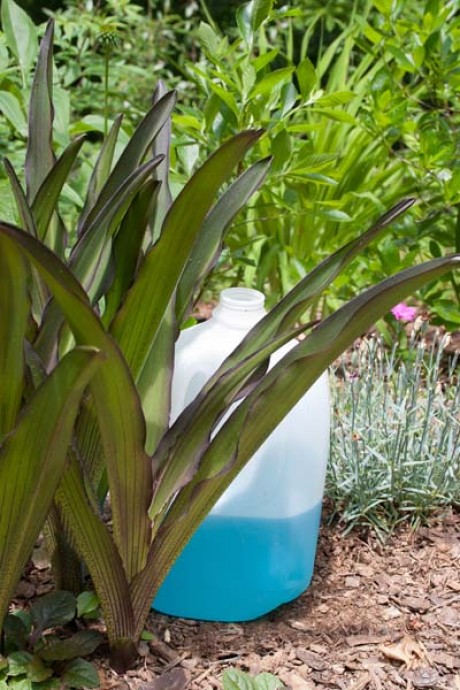Milk made
Plus garden to do's for June & July
By L.A. JacksonThere are two reasons to drink milk: (1) It’s good for you, and (2) the plastic gallon jug it comes in is good for your garden. For mixing growing solutions in particular, these containers are handy as measuring tools. Many times, plant food and pesticide instructions require a certain amount of chemical to be mixed with a gallon of water, and who has a measuring cup that big? If you drink milk, you do.
A milk jug can also be converted into an efficient irrigator for a plant beyond the reach of the water hose. Simply punch two tiny holes in the bottom, fill it with water (or a weak fertilizer solution) and set it next to a young plant with the holes pointed towards the plant. Leave the top on loosely to create a slight vacuum — it will cause the solution to slowly leak into the ground, assuring the plant a long, thorough soaking.
If you cut a milk jug in half just below the handle, you will have four useful garden items. By poking a small hole in the bottom portion for drainage, the lower half becomes a planter — not a pretty planter, mind you, but a functional one all the same. And if it is filled with a rambler such as creeping Jenny, mint or creeping thyme that readily crawls over and covers the sides, who’s going to see the container anyway?
With the cap off, the top half of the milk jug can be a funnel. The large opening makes it handy for such jobs as pouring grass seed or fertilizer into a hand-held spreader or gasoline into motorized garden equipment. With the cap on, it becomes a scoop with a handle for dirt, fertilizer, lime, water or whatever.
Finally, if you are using an all-purpose herbicide close to some of your favorite plants (especially on a windy day), take the cap back off, invert the funnel over an offending weed, spray into the container top and then move on to the next weed.
Garden To Do’s
June
- Any holes that have begun to appear in the flower bed can be quickly filled with heat-seekers such as sun coleus, celosia, impatiens, nicotiana, portulaca and zinnia that thrive in the summer sun.
- Add flowering magic to the backyard pond by dropping in a few tropical water lilies. Add fertilizer to each of the plants’ pots, as these heavy-feeders need the extra nutrients for maximum bloom production.
- Lightly side-dress with fertilizer any established vegetables that have begun to set crops.
- Rake up and discard any fallen fruit and leaves from underneath fruit trees to discourage insects and diseases that could cause problems later.
- For the same reason, start raking up and disposing spent petals and foliage of roses.
July
- To maximize production from your tomato plants, pinch off any suckers that are growing below the fruits. However, the suckers above the fruits should remain because they help provide the fruits some relieving shade from the incessant shine of the summer sun.
- Pinched tomato suckers can produce this fall’s tomato crop. Place each sucker in a 2 to 3-inch container of potting soil and keep them moist in a lightly shaded spot. The suckers will quickly root and be ready to plant when you prepare your fall vegetable garden.
- Herbs are usually at their harvesting best just before flowering when they contain the maximum in essential oils. Pick herbs early in the morning before the sun has a chance to heat the plants up.
- Houseplants vacationing outside should be watched for signs of insect activity such as egg laying that could become infestations once they are brought back inside in the fall. Wiping the leaves occasionally (both on top and underneath) with a damp cloth will help waylay egg-laying activities.
- Enjoy a good drink after a day in the garden? Your insect-eating feathered friends do, too, so be sure to clean out and refill the birdbath at least once a week during the hot, hazy days of summer.
-
Share this story:




